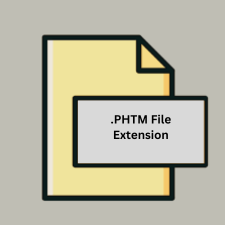.PHTM File Extension

What is an PHTM file?
The .PHTM file extension is associated with PHP-based web pages. These files are typically used to store and render web content dynamically on the server side using PHP (Hypertext Preprocessor). PHP is a popular server-side scripting language designed for web development but also used as a general-purpose language.
More Information.
The PHP language was created in 1994 by Rasmus Lerdorf. Initially, it was a set of Common Gateway Interface (CGI) binaries written in the C programming language. Over time, PHP evolved into a full-fledged server-side scripting language with a rich set of features. The .PHTM extension, though not widely adopted, serves the same purpose as .PHP files by enabling dynamic content generation and server-side processing of web pages.
Origin Of This File.
The .PHTM extension is not standard; it is a variant of the .PHP extension, which is more commonly used. Some developers or systems might use .PHTM as an alternative to .PHP for organizational or compatibility reasons.
File Structure Technical Specification.
A .PHTM file contains PHP code embedded within HTML. The PHP code is processed on the server, and the result is sent to the client’s web browser as HTML. The structure of a .PHTM file is similar to that of an HTML file but includes PHP code blocks, which are enclosed in <?php ... ?> tags.
How to Convert the File?
Windows:
- Method: Rename File Extension
- Open File Explorer: Navigate to the directory where the .PHTM file is located.
- Show File Extensions: Ensure that file extensions are visible. You can do this by going to the “View” tab and checking the “File name extensions” box.
- Rename the File: Right-click on the .PHTM file, select “Rename,” and change the extension from
.phtmto.php. For example, renameexample.phtmtoexample.php. - Confirm the Change: You may be prompted to confirm that you want to change the file extension. Click “Yes” to proceed.
Linux:
- Method: Rename File Extension
- Open Terminal: Use the terminal application (e.g., GNOME Terminal, Konsole).
- Navigate to Directory: Use the
cdcommand to go to the directory containing the .PHTM file.
- Rename the File: Use the
mvcommand to rename the file. For example:
macOS:
- Method: Rename File Extension
- Open Finder: Navigate to the location of the .PHTM file.
- Show File Extensions: If file extensions are not visible, you can enable them in Finder preferences. Go to Finder > Preferences > Advanced, and check “Show all filename extensions.”
- Rename the File: Click on the .PHTM file, press Enter to make it editable, and change the extension from
.phtmto.php. For example, renameexample.phtmtoexample.php. - Confirm the Change: Confirm the extension change if prompted.
Android:
- Method: Rename File Using File Manager
- Install a File Manager App: Use a file manager app like ES File Explorer, Solid Explorer, or a similar app.
- Navigate to File: Open the file manager app and navigate to the .PHTM file.
- Rename the File: Long-press on the file to select it, choose the rename option, and change the file extension from
.phtmto.php. For example, renameexample.phtmtoexample.php.
iOS:
- Method: Rename File Using a File Manager App
- Install a File Manager App: Use an app like Files or Documents by Readdle.
- Navigate to File: Open the app and locate the .PHTM file.
- Rename the File: Use the app’s file management features to rename the file extension from
.phtmto.php. This process varies slightly depending on the app, but generally involves selecting the file and using an option to rename it.
Other Environments:
- General Method: Rename File Extension
- Use File Manager or Command Line: Depending on the environment, use either a graphical file manager or command line interface to navigate to the file’s location.
- Rename the File: Change the file extension from
.phtmto.php. The process will vary based on the specific tools or file management systems available.
Advantages And Disadvantages.
- Advantages:
- Allows for dynamic content generation.
- Supports complex functionalities such as database interactions and user authentication.
- PHP is widely supported and has extensive documentation and community support.
- Disadvantages:
- Requires a web server with PHP installed to process the file.
- Security vulnerabilities if not properly coded (e.g., SQL injection, cross-site scripting).
How to Open PHTM?
Open In Windows
Use a web server with PHP installed, such as XAMPP, WAMP, or IIS with PHP support. Open the file through the web server by navigating to http://localhost/yourfile.phtm.
Open In Linux
Use a web server with PHP installed, such as Apache or Nginx. Open the file through the web server by navigating to http://localhost/yourfile.phtm in a web browser.
Open In MAC
Use a web server with PHP installed, such as MAMP or the built-in Apache server in macOS. Open the file through the web server by navigating to http://localhost/yourfile.phtm in a web browser.
Open In Android
View .PHTM files through a web server that is accessible from the Android device. You can use a web server app or host the file on a remote server and access it via a web browser.
Open In IOS
Similar to Android, .PHTM files can be accessed through a web server from an iOS device using Safari or any other web browser app.
Open in Others
Any platform or device with a compatible web server setup can handle .PHTM files. This includes various operating systems and devices as long as the server-side processing of PHP is supported.













